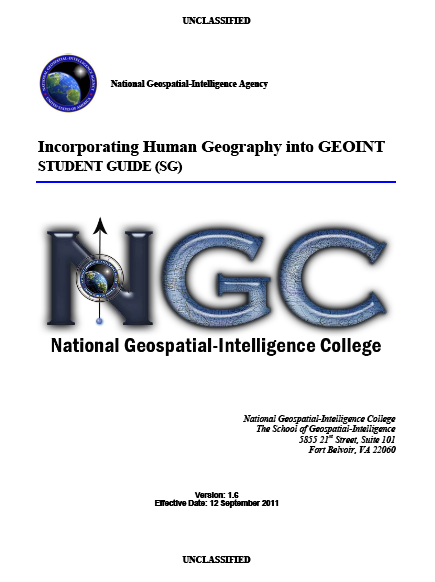The following document on the incorporation of human terrain into geographic intelligence analysis was posted earlier this month to the document sharing website Scribd.
National Geospatial-Intelligence College
- Version 1.6
- 157 pages
- September 12, 2011
- 5 MB
This course provides an overview of incorporating Human Geography into GEOINT at NGA, with the intention of providing a foundation of the knowledge, skills, and application capabilities for the NGA GEOINT analyst. By the end of the course, you will:
• Understand the relevance and need to incorporate Human Geography into GEOINT
• Be familiar with Human Geography concepts and data
• Be able to apply the NGA workflow process, including Human Geography data needs, acquisition, and challenges…
Human Terrain Defined
Incorporating Human Geography into GEOINT can be used to support efforts to understand the human terrain. But what is ‘human terrain’?
One definition describes human terrain as “the social, ethnographic, cultural, economic, and political elements of the people among whom a force is operating.”
Human terrain is not a new concept; the need for understanding the behavior of adversaries and their culture, as well as that of the local populations with whom our military forces, diplomats, and aid organizations work, has been identified before: General Petraeus noted that “You have to understand not just what we call the military terrain… the high ground and low ground. It’s about understanding the human terrain, really understanding it.”
• World War II / Korea
• JANIS: Joint Army Navy Intelligence Studies
• Vietnam
• Hamlet Evaluation System
• Attempt to measure the socio-economic, political, security conditions in a COIN environmentHT Analysis (HTA) is an evolving concept, and is often modified to meet specific organizational needs, requirements, and missions.
(U) Current efforts and challenges include creating a:
• Standardized doctrine
• Centralized database
• Shared lexicon
• Single HTA qualification course
• Product standardization
• Workflow methodologyEfforts to develop and implement greater understanding of the ‘human terrain’ across the IC include:
• Defense Intelligence Agency
• DISCCC: Defense Intelligence Socio-Cultural Capabilities Council
• Human Factors Analysis Division
• US Combatant Commands
• Human Terrain Analysis Team
• Cultural and Human Environment Team
• US Special Operations Command
• National Air and Space Intelligence Center
• Service Intelligence CentersGoal for NGA
“Create new value by broadening and deepening our analytic expertise. By providing deeper, contextual analysis of places informed not only by the earth’s physical features and imagery intelligence, but also by ‘human geography’.”
GEOINT is synonymous with a deep contextual understanding of places…of locations on the Earth. This understanding is informed by:
• what we know about the Earth’s physical features
• what structures people build
• how people use those structures – their activities
• human geography – data and information that can be understood spatially and depicted visually that further deepens and enriches our understanding of a “place.”…


